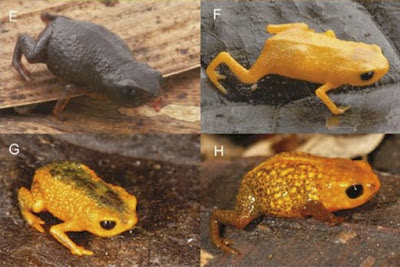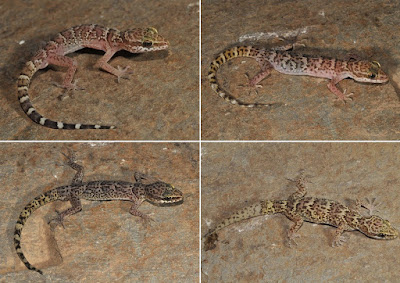[Most Recent Entries] [Calendar View]
Tuesday, July 24th, 2018
| Time | Event | ||||
| 10:06a | [Herpetology • 2018] Phylogenomics of Montane Frogs of the Brazilian Atlantic Forest is Consistent with Isolation in Sky Islands Followed by Climatic Stability
Abstract Despite encompassing a relatively small geographical area, montane regions harbour disproportionately high levels of species diversity and endemism. Nonetheless, relatively little is known about the evolutionary mechanisms that ultimately lead to montane diversity. In this study, we used target capture of ultraconserved elements to investigate the phylogenetic relationships and diversification patterns of Melanophryniscus (Bufonidae) and Brachycephalus (Brachycephalidae), two frog genera that occur in sky islands of the southern Atlantic Forest of Brazil. Specifically, we tested whether diversification of montane species in these genera could be explained by a single climatic shift leading to isolation in sky islands, followed by climatic stability that maintained populations in allopatry. In both genera, the topologies inferred using concatenation and coalescent-based methods were concordant and had strong nodal support, except for a few recent splits, which nevertheless tended to be supported by more informative loci. Estimation of divergence time of a combined dataset using both genera is consistent with a concordant timing of their diversification. These results support the scenario of diversification by isolation in sky islands and suggest that allopatry attributable to climatic gradients in montane regions is an important mechanism for generating species diversity and endemism in these regions. Brachycephalus, coalescent, Melanophryniscus, target enrichment, ultraconserved elements Marcio R. Pie, Brant C. Faircloth, Luiz F. Ribeiro, Marcos R. Bornschein and John E Mccormack. 2018. Phylogenomics of Montane Frogs of the Brazilian Atlantic Forest is Consistent with Isolation in Sky Islands Followed by Climatic Stability. Biological Journal of the Linnean Society. bly093. DOI: 10.1093/biolinnean/bly093 Marcio R. Pie, Brant C Faircloth, Luiz Fernando Ribeiro, Marcos R. Bornschein and John McCormack. 2018. Phylogenomics of montane frogs of the Brazilian Atlantic Forest supports a scenario of isolation in sky islands followed by relative climatic stability. bioRxiv. 226159. DOI: 10.1101/226159 | ||||
| 10:28a | [Herpetology • 2018] Cyrtodactylus chamba • A New Bent-toed Gecko (Squamata: Gekkonidae: Cyrtodactylus) from the Western Himalayas, Himachal Pradesh, India
Abstract We describe a new species of the gekkonid genus Cyrtodactylus based on a series of six specimens from the Chamba Valley in the Western Himalayas, Himachal Pradesh state, India. Cyrtodactylus chamba sp. nov. is a member of the subgenus Siwaligekko and can be diagnosed from congeners in the Western Himalayas by a combination of its small size (snout to vent length up to 63 mm), a continuous series of five precloacal pores on males, 13–15 rows of dorsal tubercles, 33–43 scales across the belly, no regular series of enlarged subcaudals, and a dorsal colour pattern of 5–7 irregular, broad, dark bands with much narrower, light interspaces. The new species is 14% divergent in ND2 sequence from the most similar sampled congener, Cyrtodactylus (Siwaligekko) himalayanus from Jammu and Kashmir, and is 0.5–1.1% divergent in nuclear sequence data from sampled Siwaligekko species. Many more undiscovered Cyrtodactylus species probably exist across the Himalayas at elevations below ~2000 m; basic field surveys for reptiles and other poorly known groups and examination of existing material should be a priority if we are to appreciate the true diversity of this spectacular mountainous landscape. Keywords: Reptilia, Alpha taxonomy, Cyrtodactylus lawderanus, Himalayas, lizard, ND2, Siwaligekko, systematics, taxonomy
Cyrtodactylus chamba sp. nov. Cyrtodactylus sp. Chamba (Agarwal et al. 2014a) Etymology. The specific epithet is the name of the type locality of the species and is used as a noun in apposition. Cyrtodactylus chamba sp. nov. is only known from around Chamba, in the Chamba Valley, Himachal Pradesh, India. Suggested common name. Chamba bent-toed gecko Ishan Agarwal, Akshay Khandekar and Aaron M. Bauer. 2018. A New Bent-toed Gecko (Squamata: Gekkonidae: Cyrtodactylus) from the Western Himalayas, Himachal Pradesh, India. Zootaxa. 4446(4); 442–454. DOI: 10.11646/zootaxa.4446.4.2 Agarwal, I., Bauer, A.M., Jackman, T.R. & Karanth, K.P. 2014. Insights into Himalayan Biogeography from Geckos: A Molecular Phylogeny of Cyrtodactylus (Squamata: Gekkonidae). Molecular Phylogenetics and Evolution. 80, 145–155. DOI: 10.1016/j.ympev.2014.07.018 |
| << Previous Day |
2018/07/24 [Calendar] |
Next Day >> |







